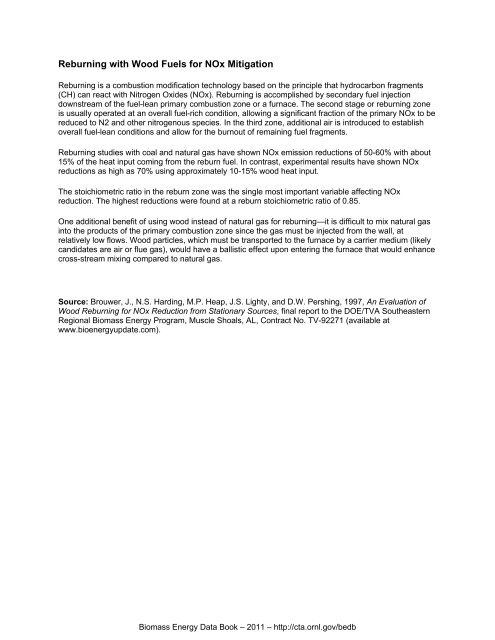Biomass Energy Data Book: Edition 4 - Full Document - Center for ...
Biomass Energy Data Book: Edition 4 - Full Document - Center for ...
Biomass Energy Data Book: Edition 4 - Full Document - Center for ...
Create successful ePaper yourself
Turn your PDF publications into a flip-book with our unique Google optimized e-Paper software.
Reburning with Wood Fuels <strong>for</strong> NOx Mitigation<br />
Reburning is a combustion modification technology based on the principle that hydrocarbon fragments<br />
(CH) can react with Nitrogen Oxides (NOx). Reburning is accomplished by secondary fuel injection<br />
downstream of the fuel-lean primary combustion zone or a furnace. The second stage or reburning zone<br />
is usually operated at an overall fuel-rich condition, allowing a significant fraction of the primary NOx to be<br />
reduced to N2 and other nitrogenous species. In the third zone, additional air is introduced to establish<br />
overall fuel-lean conditions and allow <strong>for</strong> the burnout of remaining fuel fragments.<br />
Reburning studies with coal and natural gas have shown NOx emission reductions of 50-60% with about<br />
15% of the heat input coming from the reburn fuel. In contrast, experimental results have shown NOx<br />
reductions as high as 70% using approximately 10-15% wood heat input.<br />
The stoichiometric ratio in the reburn zone was the single most important variable affecting NOx<br />
reduction. The highest reductions were found at a reburn stoichiometric ratio of 0.85.<br />
One additional benefit of using wood instead of natural gas <strong>for</strong> reburning—it is difficult to mix natural gas<br />
into the products of the primary combustion zone since the gas must be injected from the wall, at<br />
relatively low flows. Wood particles, which must be transported to the furnace by a carrier medium (likely<br />
candidates are air or flue gas), would have a ballistic effect upon entering the furnace that would enhance<br />
cross-stream mixing compared to natural gas.<br />
Source: Brouwer, J., N.S. Harding, M.P. Heap, J.S. Lighty, and D.W. Pershing, 1997, An Evaluation of<br />
Wood Reburning <strong>for</strong> NOx Reduction from Stationary Sources, final report to the DOE/TVA Southeastern<br />
Regional <strong>Biomass</strong> <strong>Energy</strong> Program, Muscle Shoals, AL, Contract No. TV-92271 (available at<br />
www.bioenergyupdate.com).<br />
<strong>Biomass</strong> <strong>Energy</strong> <strong>Data</strong> <strong>Book</strong> – 2011 – http://cta.ornl.gov/bedb
















